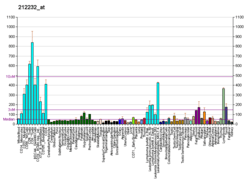FNBP4
| FNBP4 | |||||||||||||||||||||||||
|---|---|---|---|---|---|---|---|---|---|---|---|---|---|---|---|---|---|---|---|---|---|---|---|---|---|
| Identifiers | |||||||||||||||||||||||||
| Aliases | FNBP4, FBP30, formin binding protein 4 | ||||||||||||||||||||||||
| External IDs | MGI: 1860513 HomoloGene: 9087 GeneCards: FNBP4 | ||||||||||||||||||||||||
| |||||||||||||||||||||||||
| |||||||||||||||||||||||||
| |||||||||||||||||||||||||
| Orthologs | |||||||||||||||||||||||||
| Species | Human | Mouse | |||||||||||||||||||||||
| Entrez | |||||||||||||||||||||||||
| Ensembl | |||||||||||||||||||||||||
| UniProt | |||||||||||||||||||||||||
| RefSeq (mRNA) | |||||||||||||||||||||||||
| RefSeq (protein) | |||||||||||||||||||||||||
| Location (UCSC) | Chr 11: 47.72 – 47.77 Mb | Chr 2: 90.75 – 90.78 Mb | |||||||||||||||||||||||
| PubMed search | [3] | [4] | |||||||||||||||||||||||
| Wikidata | |||||||||||||||||||||||||
| |||||||||||||||||||||||||
Formin-binding protein 4 is a protein that in humans is encoded by the FNBP4 gene.[5][6]
Mutations in this gene have been found associated to cases similar to microphthalmia with limb anomalies (doi: 10.1002/ajmg.a.35983).
References
- 1 2 3 ENSG00000285182 GRCh38: Ensembl release 89: ENSG00000109920, ENSG00000285182 - Ensembl, May 2017
- 1 2 3 GRCm38: Ensembl release 89: ENSMUSG00000008200 - Ensembl, May 2017
- ↑ "Human PubMed Reference:".
- ↑ "Mouse PubMed Reference:".
- ↑ Nagase T, Ishikawa K, Suyama M, Kikuno R, Hirosawa M, Miyajima N, Tanaka A, Kotani H, Nomura N, Ohara O (Jul 1999). "Prediction of the coding sequences of unidentified human genes. XIII. The complete sequences of 100 new cDNA clones from brain which code for large proteins in vitro". DNA Res. 6 (1): 63–70. doi:10.1093/dnares/6.1.63. PMID 10231032.
- ↑ "Entrez Gene: FNBP4 formin binding protein 4".
Further reading
- Bedford MT, Sarbassova D, Xu J, et al. (2000). "A novel pro-Arg motif recognized by WW domains". J. Biol. Chem. 275 (14): 10359–69. doi:10.1074/jbc.275.14.10359. PMID 10744724.
- Bedford MT, Frankel A, Yaffe MB, et al. (2000). "Arginine methylation inhibits the binding of proline-rich ligands to Src homology 3, but not WW, domains". J. Biol. Chem. 275 (21): 16030–6. doi:10.1074/jbc.M909368199. PMID 10748127.
- Zucconi A, Dente L, Santonico E, et al. (2001). "Selection of ligands by panning of domain libraries displayed on phage lambda reveals new potential partners of synaptojanin 1". J. Mol. Biol. 307 (5): 1329–39. doi:10.1006/jmbi.2001.4572. PMID 11292345.
- Nakayama M, Kikuno R, Ohara O (2003). "Protein-protein interactions between large proteins: two-hybrid screening using a functionally classified library composed of long cDNAs". Genome Res. 12 (11): 1773–84. doi:10.1101/gr.406902. PMC 187542. PMID 12421765.
- Strausberg RL, Feingold EA, Grouse LH, et al. (2003). "Generation and initial analysis of more than 15,000 full-length human and mouse cDNA sequences". Proc. Natl. Acad. Sci. U.S.A. 99 (26): 16899–903. doi:10.1073/pnas.242603899. PMC 139241. PMID 12477932.
- Ota T, Suzuki Y, Nishikawa T, et al. (2004). "Complete sequencing and characterization of 21,243 full-length human cDNAs". Nat. Genet. 36 (1): 40–5. doi:10.1038/ng1285. PMID 14702039.
- Colland F, Jacq X, Trouplin V, et al. (2004). "Functional proteomics mapping of a human signaling pathway". Genome Res. 14 (7): 1324–32. doi:10.1101/gr.2334104. PMC 442148. PMID 15231748.
- Beausoleil SA, Jedrychowski M, Schwartz D, et al. (2004). "Large-scale characterization of HeLa cell nuclear phosphoproteins". Proc. Natl. Acad. Sci. U.S.A. 101 (33): 12130–5. doi:10.1073/pnas.0404720101. PMC 514446. PMID 15302935.
- Rual JF, Venkatesan K, Hao T, et al. (2005). "Towards a proteome-scale map of the human protein-protein interaction network". Nature. 437 (7062): 1173–8. doi:10.1038/nature04209. PMID 16189514.
This article is issued from
Wikipedia.
The text is licensed under Creative Commons - Attribution - Sharealike.
Additional terms may apply for the media files.




